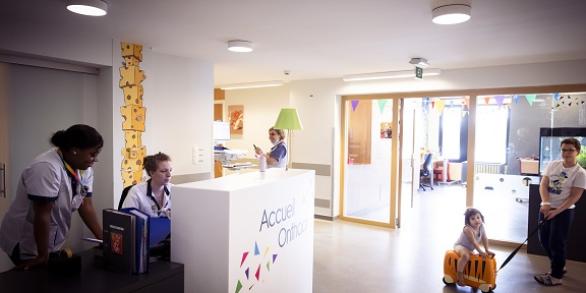We're hiring ! Join us and make a difference in our hospitals
Quality and safety
Simple actions but essential for a safe hospital.
For many years the Children's Hospital has adopted an approach to promote quality and safety for patients by putting into place procedures and evaluation indicators.
A long-term approach
An approach in which patients and their loved ones are actively involved.

Your child's identification bracelet
Correctly identifying your child is essential to safety during his or her stay at the hospital and a priority for the HUDERF. The identification bracelet is a mini identity file for your child within the hospital, with details of last name, first name, date of birth. Your child will be issued with it on arrival. This eliminates any risk of identity confusion and guarantees that the right treatment is administered to the right patient.
How to play your part in safe care for your child?
- Check the data on your child's identity bracelet
- Never remove the bracelet before your child leaves the hospital
- Assist us when we check your child's identification at the time of each examination or treatment
- Have your child's name checked if you have the slightest doubt
- Don't hesitate to ask for an explanation in case of doubt
- Don't hesitate to ask for a new bracelet if the one you have is damaged or illegible
Safety in bed and in the room
Your child's state of health may increase the risk of having a fall.
Here is some advice on how to avoid falls:
- Fit the sides of the bed (especially for beds with bars for very young children) as soon as you leave your child's bedside
- Place the bed at the lowest level and secure it in position.
- Leave your child in his or her own bed when you rest
- Ensure your child's shoes or slippers are a firm fit for the feet
- Keep the room tidy so it is easy to move around
- Gather up any wires or devices to avoid tripping over them
- Move around slowly in the room
- Inform a member of staff when you leave your child's room
Preventing and controlling infections: hygiene at the hospital
A few precautions:
- To limit the risk of spreading germs, disinfect your hands! You will find bottles of hydroalcoholic solution at various places in the hospital
- Avoid coming to the hospital if you or an accompanier (brother, sister) has a temperature, spots, diarrhoea, flu or any other contagious illness
- Do not go from one room to another
- Avoid having visitors using the toilet in your child's room or sitting on the bed. Toilets for parents and visitors are available on every floor.
In some cases, if a person is contagious for example, staff wear a facemask, medical gown and gloves.

Become a player in your child's safety
You have many opportunities to assist and participate in your child's examinations and treatment. Exception: The operating theatre is reserved strictly for professionals and the child psychiatry unit does not allow parents to stay overnight with the child.
Safety of medicines
When your child takes a medicine, you should ask yourself 4 questions:
- What is this medicine, why take it? What are the risks if the child does not take it?
- How often should your child take it?
- How to correctly administer the medicine?
- Why is this important?
Asking these questions makes it possible to engage in a constructive dialogue around the treatment and become an active player in your child's safety. As a first step, making sure you are well informed is essential!